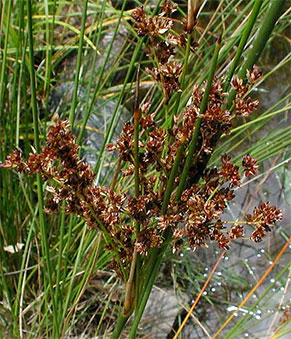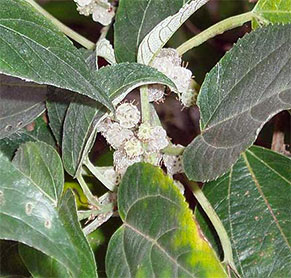
Daisy (Sunday) Derwin, age 5
Bush Tucker and Other Useful Plants
We are going to share a little secret with you.
Fish Creek is more than just a place where plants and animals live. This special habitat is also a living supermarket, chemist and hardware store all rolled into one.
Aboriginal and Torres Strait Islander peoples have used native plants for thousands of years as a food source, as a medicine or as a tool or material to construct a variety of different things.
If you would like an opportunity to see a range of bush tucker and other useful plants growing in a beautiful, natural, safe environment, you may like to visit Balaangala Community Garden in The Gap. You can contact Balaangala Community Group via email at [email protected] or through their Balaangala Community Group Facebook page.
Following are some examples of bush tucker and other useful plants that may grow around Fish Creek and The Gap local area:
IMPORTANT WARNING!
Never, ever eat any part of any plant unless you know exactly what it is.
Always remember that some plants are poisonous – they could harm or even kill you if you were to eat them. It is important you also take great care to avoid eating plants growing in a place where they may have been sprayed with chemicals. This could also make you very sick.
Finger lime
Citrus australasica (RUTACEAE)
Finger lime is a small, slow growing tree that naturally occurs in rainforests throughout North Eastern New South Wales and into South East Queensland. The fruit of this tree is long and narrow and can be many different colours, including green, yellow, black, purple or even red.
The finger lime’s pulp may be green, yellow or pink. The pulp is edible and has a very strong, sour citrus flavour. Some people consider finger lime to be an “up and coming” new food trend. Thousands of different recipe ideas, ranging from cupcakes and cordials to oysters and caviar, feature the finger lime as an important ingredient.
Juncus
Juncus usitatus (JUNCACEAE)
Juncus is a perennial, densely tufted rush plant that can often be seen growing along waterways including around The Gap local area and in other moist places. The plant features thin, long, very strong stems. This feature made it a very useful plant for first Australians to make string or for basket weaving.
Juncus is also a very important plant in our local habitat as it provides useful cover, protection and food for small animals that live in or hide amongst its foliage. The dense habit of the plant also makes it a good, safe place for some types of birds to nest, particularly in wetland areas. Juncus is often used in habitat restoration projects because the plant has a special ability to grow right to the water’s edge. This can help to stabilise the creek banks.
Long-leaved Matrush
Lomandra longifolia (LOMANDRACEAE)
The long-leaved matrush grows up to around 1 metre in height and has clumping, long, flat leaves. This plant is a very familiar sight around The Gap, South East Queensland, growing in many private gardens and in public spaces, including by the side of many roads in and around the local area.
The long-leaved matrush grows in many different habitats including around creek banks, coastal dunes and in rainforests. By splitting and soaking the leaves of this plant, first Australian peoples made net bags and traps for fish.
The long-leaved matrush is also Bush Tucker, with the white leaf bases tasting like raw green peas. As a hardy plant, the long-leaved matrush can also act as a pioneer along waterways, like Fish Creek. A pioneer plant is one that can grow in harsh conditions and in poor soils. It improves the area where it is growing and helps to make it suitable or other plants to grow there as well.
Native mulberry
Pipturus argenteus (URTICACEAE)
Native mulberry is a straggly shrub or small tree that grows to a height of 6 metres. It naturally grows in subtropical, dry and riverine rainforest areas from Northern New South Wales and up into North Queensland. When it has access to a good water supply, the native mulberry will grow very quickly. Because of this, it is often used as a pioneer plant. A pioneer plant is one that can grow in harsh conditions and in poor soils. It improves the area where it is growing and makes it easier for other plants to grow.
The plant also acts as a host for several different species of butterflies and other insects with the adult butterflies using the flowers of this tree for nectar.
Importantly, the tree also produces small, sweet, edible soft fruit. As well as being a food source, this plant has several important uses in Aboriginal culture. The bark of the plant made a very useful brown dye, the fibres used to make cloth and the inner bark was/is used to make fishing lines and fishing nets.
Sandpaper Fig
Ficus coronata (MORACEAE)
Growing up to 12 metres tall, the sandpaper fig grows along creeks, in rainforests and in the open countryside, including around The Gap local area. The sandpaper fig is a very useful plant and has a variety of uses, including:
- The leaves can be used as very fine sandpaper;
- The milky latex from young shoots has been used by first Australians to heal wounds;
- When fully ripe, the fruit is edible; and
- The tree is a very useful pioneer tree and helps to stabilise creek banks.
With such a diverse range of practical benefits, the sandpaper fig is an incredibly useful plant growing around our local environment!





